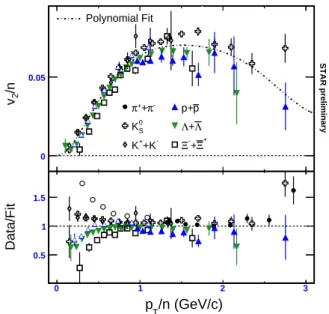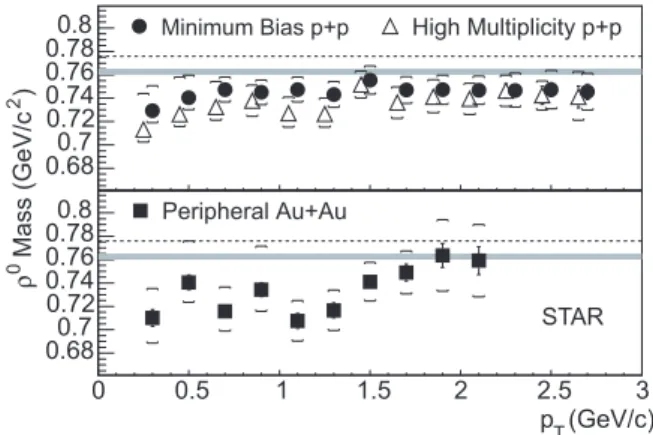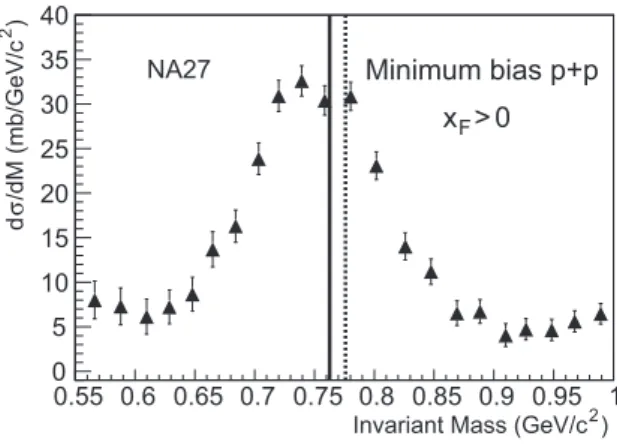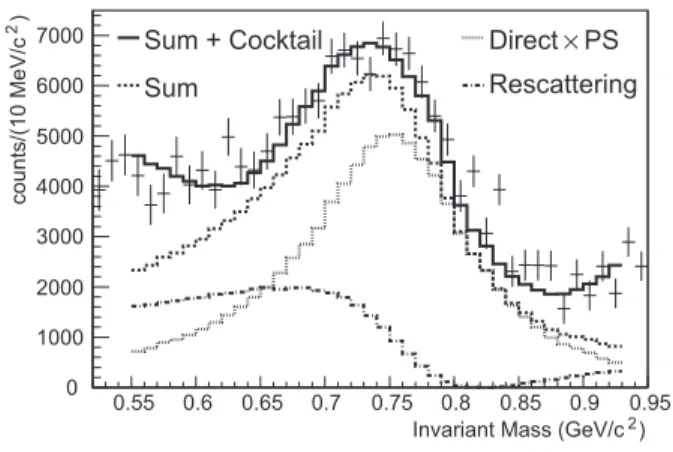Particle Production from Soft Processes
Patricia Fachini
Brookhaven National Laboratory, Upton, NY 11973 USA
Received on 30 October, 2006; revised version received on 21 March, 2007
Relativistic heavy-ion collisions provide a unique environment to study matter under extreme conditions of high temperature and energy density. In the softpTregion (≤2 GeV/c) particle production is governed by the bulk properties (e.g. hydrodynamic pressure, freeze-out temperature) of the collisions. Total particle yields as well as their distributions in phase space are strongly dependent on these properties. These bulk properties will be discussed and we will compare our heavy-ion results to measurements in thep+preference system, where multiparticle processes such as recombination and rescattering are generally thought to be negligible. However, we will show evidence forπ+π−rescattering interactions even inp+pcollisions.
Keywords: Soft interaction; Elliptic flow; Mass modification
I. ELLIPTIC FLOW
In non-central collisions the initial spatial anisotropy is transformed into an anisotropy in momentum-space if suffi-cient interactions occur among the constituents within the sys-tem. Once the system has expanded enough to quench the spa-tial anisotropy, further development of momentum anisotropy ceases. This self-quenching process happens quickly, so ellip-tic flow is primarily sensitive to the early stages of the colli-sions [1].
A. Hydrodynamics
The elliptic flowv2as a function ofpTforKS0,Λ,φ,Ξ, andΩ is depicted in Fig. 1 [2, 3]. Theφ,Ξ, andΩhave low hadronic cross-sections, therefore the largev2observed suggest that the elliptic flow is built up in the partonic stage. The expected range ofv2from hydrodynamic calculations is also shown in Fig. 1.
0 2 4 6
0 0.1 0.2
S 0 K
Λ
+
Λ
Hydro
0 2 4 6
STAR preliminary
φ
+
Ξ
+
-Ξ + Ω
+
-Ω
(GeV/c) T Transverse Momentum p
2
v
FIG. 1: Azimuthal anisotropyv2for strange (left panel) and multi-strange (right panel) hadrons in minimum bias Au+Au collisions [2]. Data measured by STAR. The dashed lines show a common fit to the KS0andΛ+Λdata [5]. The shaded areas are hydrodynamic calcula-tions [1]
A more detailed comparison can be seen in Fig. 2, where the mass dependent hydrodynamic results [1] are compared to
thev2 measurements of π,K,p, andΛ [4]. Hydrodynamics describes well the mass dependence observed in the data that is characteristic of a common flow velocity. Since an ideal hydrodynamic fluid is a thermalized system with a zero mean free path that yields the maximum possiblev2, the good agree-ment between the measuredv2and the hydro results [1] sug-gests thermalization in heavy-ion collisions at RHIC.
-0.02 0 0.02 0.04 0.06 0.08 0.1 0.12
0 0.2 0.4 0.6 0.8 1 1.2 1.4 1.6 STAR Data
π± KS0
p−
Λ+Λ−
π
K p
Λ
Hydrodynamic results
π± systematic error
Transverse momentum pt (GeV/c)
v2
-0.02
-0.02 -0.02 -0.02
FIG. 2: v2 as a function of pT from minimum bias Au+Au colli-sions [4] measured by STAR. The dotted-dashed lines are hydrody-namic calculations using an equation of estate (EOS) with a first-order hadron quark-gluon plasma phase transition [1]. The descrip-tion of the data worsen if a hadronic EOS is used [1].
B. Constituent Quark Scaling
/n2
v
Data/Fit
/n (GeV/c)
T
p 0
0.05
STAR preliminary Polynomial Fit
-π
+ +
π
0 S K
-+K + K
p p+
Λ
+
Λ
+
Ξ
+
-Ξ
0 1 2 3
0.5 1 1.5
FIG. 3: Measurements by STAR of the scaledv2(pT/n)/nfor iden-tified hadrons (upper panel) and the ratio between the measurements and a polynomial fit through all data points (lower panel) except the pions for√sNN= 200 GeV minimum bias Au+Au collisions [2].
the observed deviations from the fit follow a mass ordering which is expected from hydrodynamics. At higherpT, allv2/n measurements are reasonably close to unity showing the con-stituent quark scaling.
II. FREEZE-OUT PROPERTIES
The measured particle spectra and yields [9] and event-by-eventhpTifluctuations [10] indicate a nearly chemically and kinetically equilibrated system at the final freeze-out stage.
A. Chemical and Kinetic Freeze-out Parameters
STAR has now measured hadron distributions at √sNN = 200 and 62 GeV [11, 12]. Chemical freeze-out properties were extracted from stable particle ratios within the ther-mal model [28]. Kinetic freeze-out properties from particle pTdistributions were extracted within the blast wave model [14]. The extracted chemical freeze-out temperatureTch, the strangeness suppression factorγs, kinetic freeze-out temper-atureTkin and the average radial flow velocityhβTiat√sNN
= 62 GeV are found to be qualitatively the same as those ob-tained at √sNN = 200 GeV and resonance decays are found to have no significant effect on the extract kinetic freeze-out parameters [12].
Tch is independent of centrality. Tkin obtained fromπ,K, and p decreases as a function of centrality, while the corre-spondinghβTiincreases. This is evidence that the system ex-pands between chemical and kinetic freeze-outs, which brings the system to a lower temperature. γsincreases fromp+pto
peripheral and central Au+Au collisions. In central Au+Au collisions,γs is ∼1 suggesting that strangeness is saturated. The Tch of φ,Ξ, and Ω is higher than that of π,K, and p, while thehβTiis lower. Noting that theφ,Ξ,andΩhave small hadronic cross-sections, they may chemically and kinetically freeze-out at the same time.
B. Resonances
In order to study different hadronic interactions effects on different resonances in relativistic heavy-ion collisions, one should compare the potential differences in the ratio of the resonance to its corresponding ground state. Figure 4 depicts theK∗/K−,φ/K−, andρ0/π− yield ratios as a functions of
dNrmch/dηfor Au+Au collisions at√sNN = 200 GeV
mea-sured by STAR [34]. All yield ratios have been normalized to the corresponding yield ratio measured in minimum biasp+p collisions at the same c.m. system energy and indicated by the solid line in Fig. 4. TheK∗/K−yield ratio for central Au+Au collisions is significantly lower than the minimum biasp+p measurement at the same√sNN.
In addition, the statistical model prediction ofK∗0/K−is
2σhigher than the measurement [34]. The lowerK∗/K−yield ratio measured may be due to the rescattering of theK∗0decay products. Due to the relatively long lifetime of theφmeson and the negligibleKKcross-section, the rescattering of theφ decay products and the phi regeneration should be negligible. The statistical model prediction for theφ/K−yield ratio in-deed agrees with the measurement [34].
η
Ǚ ǙǙ ǙǙ ǙǙ ǙǙ ǙǙ ǙǙ ƞǙǙ
į
Ǚ Ǚƽ
ƽ
φ π ρ
FIG. 4: TheK∗/K−,φ/K−,andρ0/π−yield ratios as a functions
III. EVIDENCE FORπ+π−SCATTERING INp+p COLLISIONS
Theρ0was measured via its hadronic decay channel in min-imum bias p+pand Au+Au collisions at RHIC and a mass shift of−40 and−70 MeV/c2of the position of theρ0 was observed, respectively. While no explanations were explicitly attributed to the mass shift in p+p collisions, the possible explanations for the apparent modification of the ρ0 meson properties in Au+Au collisions were attributed to dynamical interactions with the surrounding matter, interference between variousπ+π−scattering channels, phase space distortions due to the rescattering of pions formingρ0and Bose-Einstein cor-relations between ρ0 decay daughters and pions in the sur-rounding matter [16].
Theρ0meson measured in the dilepton channel probes all stages of the system formed in relativistic heavy-ion collisions because the dileptons have negligible final state interactions with the hadronic environment. Heavy-ion experiments at CERN show an enhanced dilepton production cross section in the invariant mass range of 200-600 MeV/c2, showing that theρ0is broadened rather than shifted [17, 18].
The modification of the ρ0 properties in heavy-ion colli-sions has been expected [19], contrary to the modifications of theρ0properties in p+pcollisions. Similar modifications of that measured inp+pcollisions at RHIC has been observed before at CERN-LEBC-EHS and CERN-LEP. Until now, the mass shift measured inp+pat CERN-LEBC-EHS has been attributed to phase space.
A. Discussionρmass average from the Particle Data Group (PDG)
We will first discuss theρmass average from the PDG [26]. The ρ0 mass average 775.8 ± 0.5 MeV/c2 from e+e− was obtained from eithere+e−→π+π−ore+e−→π+π−π0. This means that theρ0mass average was obtained fromexclusive leptonic reactions. Similarly, theρ±mass average 775.5± 0.5 MeV/c2 was also was obtained fromexclusive leptonic reactions.
Theρaverages reported by the PDG from reactions other than leptonic interactions are systematic lower than the value obtained fromleptonic exclusive interactionsby∼10 MeV/c2 [26]. Theρproduction in these hadronic reactions are inclu-sive and excluinclu-sive. In the case of incluinclu-sive productions, the phase space was take into account when theρmass was mea-sured (e.g. [20]).
These observations lead us to conclude that theρmass de-pends on specific interactions, e.g. whether theρis produced in inclusive or exclusive reactions. Since a leptonic reaction and exclusive measurement of theρ0lead to a negligible mod-ification of any kind of theρ0mass, the average 775.8±0.5 MeV/c2[26] frome+e−should correspond to theρ0mass in the vacuum.
)
2
Mass (GeV/c
0
ρ
0.680.7 0.72 0.74 0.76
0.780.8 Minimum Bias p+p High Multiplicity p+p
(GeV/c) T p
0 0.5 1 1.5 2 2.5 3
0.680.7 0.72 0.74 0.76
0.780.8 Peripheral Au+Au
STAR
FIG. 5: Theρ0mass as a function of pT for minimum bias p+p (filled circles), high multiplicityp+p(open triangles), and periph-eral Au+Au (filled squares) collisions measured by STAR. The error bars indicate the systematic uncertainty. Statistical errors are negli-gible. Theρ0mass was obtained by fitting the data to the BW×PS functional form described in [16]. The dashed lines represent the average of theρ0 mass measured ine+e− [26]. The shaded areas
indicate theρ0 mass measured inp+pcollisions [20]. The open triangles have been shifted downward on the abscissa by 50 MeV/c for clarity.
B. ρ0mass shifts at RHIC, CERN-LEBC-EHS, and CERN-LEP
Theρ0was measured in the hadronic decay channelρ0→
π+π− at RHIC, CERN-LEBC-EHS, and CERN-LEP in in-clusive production. At RHIC, the STAR collaboration mea-sured theρ0 at√s
NN=200 GeV at midrapidity (|y|<0.5)
and observed mass shifts of the position of theρ0 peak of
about−40 MeV/c2and−70 MeV/c2in minimum biasp+p
and peripheral Au+Au collisions, respectively [16]. Theρ0
mass obtained from the BW×PS fit to the invariant mass dis-tributions after the subtraction of the like-sign background is depicted in Fig. 5, where it is clear that the phase space does not account for the measured mass shifts of the position of the ρ0peak.
At CERN-LEBC-EHS, NA27 measured the ρ0 in
mini-mum bias p+pat√s=27.5 GeV forxF>0, where xF is
the ratio between the longitudinal momentum and the maxi-mum momentum of the meson, and reported a mass of 762.6 ± 2.6 MeV/c2 [20]. The ρ0 signal can be seen even
be-fore background subtraction. The invariantπ+π− mass dis-tribution was fit to the BW(NA27)×PS(NA27) plus a back-ground function [20]. In this analysis, the phase space func-tion (PS(NA27)) used is the same as the combinatorial back-ground (BG). The invariantπ+π−mass distribution after sub-traction of the mixed-event reference distribution is shown in Fig. 6. The vertical dashed line represent the average of the ρ0 mass 775.8±0.5 MeV/c2 measured ine+e− [26]. The
vertical solid line is theρ0mass 762.6±2.6 MeV/c2reported
by NA27 [20]. As shown in Fig. 6, the position of theρ0peak
is shifted by∼30 MeV/c2compared to the ρ0 mass in the
)
2
Invariant Mass (GeV/c
0.55 0.6 0.65 0.7 0.75 0.8 0.85 0.9 0.95 1
)
2
/d
M (
mb
/GeV/c
σ
d
0 5 10 15 20 25 30 35 40
Minimum bias p+p
> 0
F
x
NA27
FIG. 6: The invariantπ+π−mass distribution after background sub-traction for minimum biasp+pcollisions measured by NA27. For details see [20]. The vertical dashed line represent the average of the ρ0mass 775.8±0.5 MeV/c2measured ine+e−[26]. The vertical
solid line is theρ0mass 762.6±2.6 MeV/c2reported by NA27 [20].
As mentioned, NA27 obtained theρ0 mass by fitting the invariantπ+π−mass distribution to the BW×PS function, and
they reported a mass of 762.6±2.6 MeV/c2, which is∼10 MeV/c2 lower than theρ0 mass in the vacuum. Ideally, the PS factor should have accounted for the shift on theρ0 peak, and the mass obtained from the fit should have agreed with theρ0 mass in the vacuum. However, just like in the STAR measurement, this was not the case, since the phase space did not account for the mass shift on the position of theρ0peak.
At CERN-LEP, OPAL, ALEPH and DELPHI measured the ρ0in inclusivee+e−reactions at√s=90 GeV [21–24]. Even
though OPAL never reported the value of theρ0mass, OPAL reported a shift on the position of theρ0peak by∼70 MeV/c2 at low xp, where xp is the ratio between the meson and the beam energies, and no shift at highxp(xp∼1) [21, 22]. OPAL also reported a shift in the position of theρ±peak from−10 to −30 MeV/c2, which was consistent with theρ0measurement [23]. ALEPH reported the same shift on the position of ρ0 peak observed by OPAL [24]. Both OPAL and ALEPH used the like-sign method to subtract the background. DELPHI fit the raw invariantπ+π−mass distribution to the (BW×PS + BG) function forxp>0.05 and reported aρ0 mass of 757± 2 MeV/c2[25], which is five standard deviations below theρ0 mass in the vacuum (775.8±0.5 MeV/c2). As one can see, similarly to NA27, DELPHI assumed that the phase space was described by the background function. Bose-Einstein corre-lations were used to describe the shift on the position of ρ0 peak. However; high (even unphysical) chaocity parameters (λ∼2.5) were needed [21, 22, 24].
C. Phase space inp+pcollisions
In p+pcollisions, most models assume that particles are born at hadronization according to phase space without any final state interaction. In multiparticle production processes,
single-inclusive (e.g.p+p), invariant particle spectra are typ-ically exponential inpT[35]. The exponential behavior does not require final state interactions and it can be due to phase space population at hadronization. The slope parameter in p+pcollisions are independent of the particle species [36]. At RHIC, theρ0spectra in minimum bias and high multiplic-ity p+p are exponential in pTup to 1.1 GeV/c2 with slope parameters of∼180 MeV [37]. These results are also inde-pendent of the multiplicity.
However, theρ0mass measured inp+pat RHIC is multi-plicity dependent (the mass shift in high multimulti-plicity is higher than in minimum biasp+pcollisions) [16], which is opposite to the slope parameter that is multiplicity independent. Note that the systematic errors are correlate among themselves and between the two measurements. We will demonstrate that the mass should be independent of pTas well as multiplicity at hadronization without final state interactions. According to quantum mechanics, a resonance at rest is described by a probability amplitude that is proportional to a non-relativistic Breit-Wigner distribution. When the energy conservation law is imposed in the partition of string fragmentation into multi-ple hadrons, a phase space factor, similar to the Boltzmann factor in thermal distribution, has to be added to the non-relativistic Breit-Wigner distribution
P(M,pT)∝
Γ/2
(M−M0)2+Γ
2
4
×exp(−mT
T ). (1)
where M is the invariant mass (M), exp(−mT
T ) is the phase space, mT equals
q M2+p2
T and T equals 160 MeV [37]. However; as discussed previously, the phase space does not describe the mass shift of the ρ meson measured at RHIC, CERN, and LEP.
Since the phase space of a non interacting multiparticle state cannot explain the distortion of theρ0 line shape, we can conclude that the phase space inp+pcollisions also ac-counts for hadrons scattering and forming resonances. In the case of theρ0,π+π−→ρ0→π+π−. This can be pictured in
the string fragmentation particle production scenario, where the string breaks several times, two pions are formed, they scatter, and form aρ0. Such interactions are significant and modify theρ0spectral shape ine+e−and p+pfrom a
rela-tivisticp-wave Breit-Wigner function.
Using thep+pdata measured by STAR [16] and the rescat-tering formalism of [39], we can test the ideas of a mass shift having aπ+π−scattering component. The di-pion production is given by Eq. 21 of [39]. For theρ0 which is p-waveℓ=1 Eq. 21 becomes
|T|2=|D|2sin
2(δ 1) PS′ +
|A|2
PS′ ¯
¯αsin(δ1) +PS′cos(δ1)
¯ ¯ 2
(2)
Theδ1is the p-wave phase shift (ρ0) and sin
2(δ 1)
PS′ in our case becomes the Breit-Wigner times phase space equation 1.|D|2 becomes the direct production ofρ0for the p
) 2 Invariant Mass (GeV/c
0.55 0.6 0.65 0.7 0.75 0.8 0.85 0.9 0.95
)
2
cou
nts/(
1
0
MeV/c
0 1000 2000 3000 4000 5000 6000
7000 Direct × PS
Rescattering Sum + Cocktail
Sum
FIG. 7: Fit to the data using equation 2 (solid line), the directρ0 con-tribution term times the phase space (dashed line), the rescattering term (dash-dotted line) and the sum of the both (dashed line).
emerging pions can re-interact or re-scatter through the p-wave quantum state or a phase shift. The phase space overlap comes from sampling theπspectrum from p+p collisions, where the sum of theπ+π−has the correctpTrange. The di-pion mass spectrum for thispTrange falls with increasing di-pion invariant mass. The variableαis related to the real part of the di-pion rescattering diagram and measures the range of interaction [39].
In order the fit thep+pdata we need to add the rest of the cocktail of resonances used by STAR [16]. Such a fit is shown in Fig. 7 (solid line), where the directρ0term time the phase
space (dotted line) and the rescattered term (dash-dotted line) plus the sum (dashed line) are also depicted.
STAR measured theρ0at midrapidity and NA27 measured at the forward region. In addition, there is the energy differ-ence of√sNN =200 and 27.5 GeV, respectively. All these facts are consistent our model, the difference between theρ0 mass shift measure by STAR and NA27 is due to pion mul-tiplicity. Similar arguments is valid for theρ measurements at CERN-LEP at√sNN=90 GeV indicating that there is also significant scattering interactions ine+e−reactions.
IV. CONCLUSIONS
There are various evidences for equilibration of the matter formed at Au+Au collisions at√sNN=200 GeV (e.g.v2 mea-surements, relative particle yields described by thermal mod-els,γS=1, etc). All these together with the constituent quark scaling are strong signatures of sQGP. I also discussed that the natural mass of theρmeson should be measured inexclusive reactions only. I showed that a shift on the position of theρ0 peak has been measured and that the phase space does not ac-count for theρ(770)0mass shift measured at RHIC, CERN-LEBC-EHS, and CERN-LEP. In addition, we discussed the phase space in p+pcollisions and concluded that there are significant scattering interactions inp+preactions.
Acknowledgement
I would like to thank F. Laue, R. Longacre, T. Ullrich, and Zhangbu Xu for the lively discussions.
[1] P. Huovinen, th/0305064; P. Kolb, and U. Heinz, nucl-th/0305084; E. V. Shuryak, Prog. Part. Nucl. Phys.53, 273 (2004).
[2] M. Oldenburget al., nucl-ex/0510026. [3] X. Caiet al., nucl-ex/0511004.
[4] J. Adamset al., Phys. Rev. C72, 014904 (2005). [5] X. Donget al., Phys. Lett. B597, 328 (2004).
[6] J. Adamset al., Phys. Rev. Lett.92, 052302 (2004); J. Adams et al., nucl-ex/0504022.
[7] J. Dunlopet al., nucl-ex/0510073.
[8] D. Molnar and S. A. Voloshin,et al., Phys. Rev. Lett.91, 92301 (2003).
[9] J. Adamset al., Phys. Rev. Lett.92, 112301 (2004). [10] J. Adamset al., nucl-ex/0308033.
[11] L. Molnaret al., nucl-ex/0507027. [12] J. Speltzet al., nucl-ex/0512037.
[28] P. Braun-Munzinger, I. Heppe, and J. Stachel Phys. Lett. B, 465, 15 (1999); N. Xu and M. Kaneta, Nucl. Phys. A698, 306 (2002).
[14] E. Schnedermann, J.Sollfrank, and U. W. Heinz Phys. Rev. C, 48, 2462 (1993); U. A. Wiedemann and U. W. Heinz, Phys. Rev. C56, 3265 (1997).
[34] J. Adamset al., Phys. Rev. C,71, 064902 (2005); [16] J. Adamset al., Phys. Rev. Lett.92, 092301 (2004).
[17] G. Agakishiev et al., Phys. Rev. Lett. 75, 1272 (1995); B. Lenkeitet al., Nucl. Phys. A661, 23 (1999).
[18] R. Arnaldiet al., Phys. Rev. Lett.96, 162302 (2006); [19] R. Rapp and J. Wambach, Adv. Nucl. Phys.25, 1 (2000). [20] M. Aguilar-Benitezet al., Z. Phys. C50, 405 (1991). [21] P.D. Actonet al., Z. Phys. C56, 521 (1992).
[22] G.D. Lafferty, Z. Phys. C60, 659 (1993); (private communica-tion).
[23] K. Ackerstaffet al., Eur. Phys. J. C5, 411 (1998). [24] D. Buskulicet al., Z. Phys. C69, 379 (1996). [25] P. Abreuet al., Phys. Lett. B298, 236 (1993). [26] S. Eidelmanet al., Phys. Lett. B592, 1 (2004). [27] H.W. Barzet al., Phys. Lett. B265, 219 (1991). [28] P. Braun-Munzinger (private communication). [29] P.F. Kolb and M. Prakash, nucl-th/0301007. [30] R. Rapp, Nucl. Phys. A725, 254 (2003).
[31] W. Broniowskiet al., Phys. Rev. C68, 034911 (2003). [32] S. Pratt and W. Bauer, Phys. Rev. C68, 064905 (2003). [33] P. Granetet al., Nucl. Phys. B140, 389 (1978). [34] J. Adamset al., Phys. Rev. C71, 064902 (2005).
[35] R. Hagedorn,Relativistic Kinematics,W.A. Benjamin, 1963; E. Byckling and K. Kajantie,Particle Kinematics, Wiley, 1973. [36] I.G. Beardenet al., Phys. Rev. Lett.78, 2080 (1997). [37] P.Fachiniet al., hep/0608029 (2006).
[38] J. Adamset al., Phys. Rev. Lett.92, 112301 (2004). Addison Wesley, 1985.
![FIG. 2: v 2 as a function of p T from minimum bias Au+Au colli- colli-sions [4] measured by STAR](https://thumb-eu.123doks.com/thumbv2/123dok_br/18982614.457601/1.892.82.434.741.923/fig-function-minimum-colli-colli-sions-measured-star.webp)



